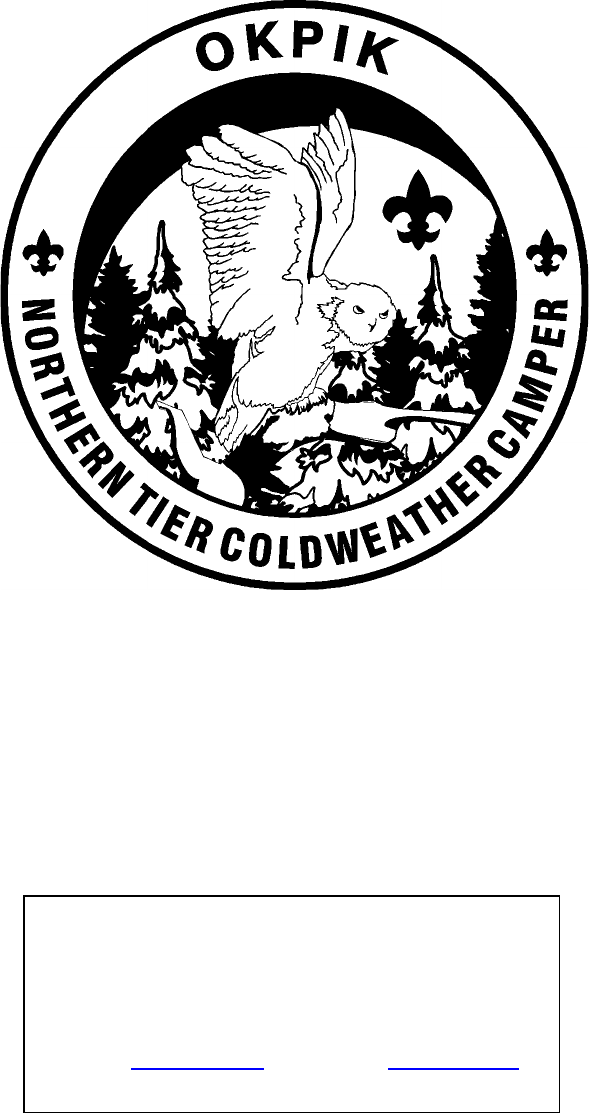
OKPIK ADVISOR
PLANNING GUIDE
2023-2024
NORTHERN TIER HIGH ADVENTURE PROGRAMS
BOY SCOUTS OF AMERICA
“Delivering Wilderness Adventure That Lasts a Lifetime”
Northern Tier High Adventure Programs
PO Box 509
Ely, MN 55731
Phone: 218.365.4811
E-mail: [email protected] Website: www.ntier.org
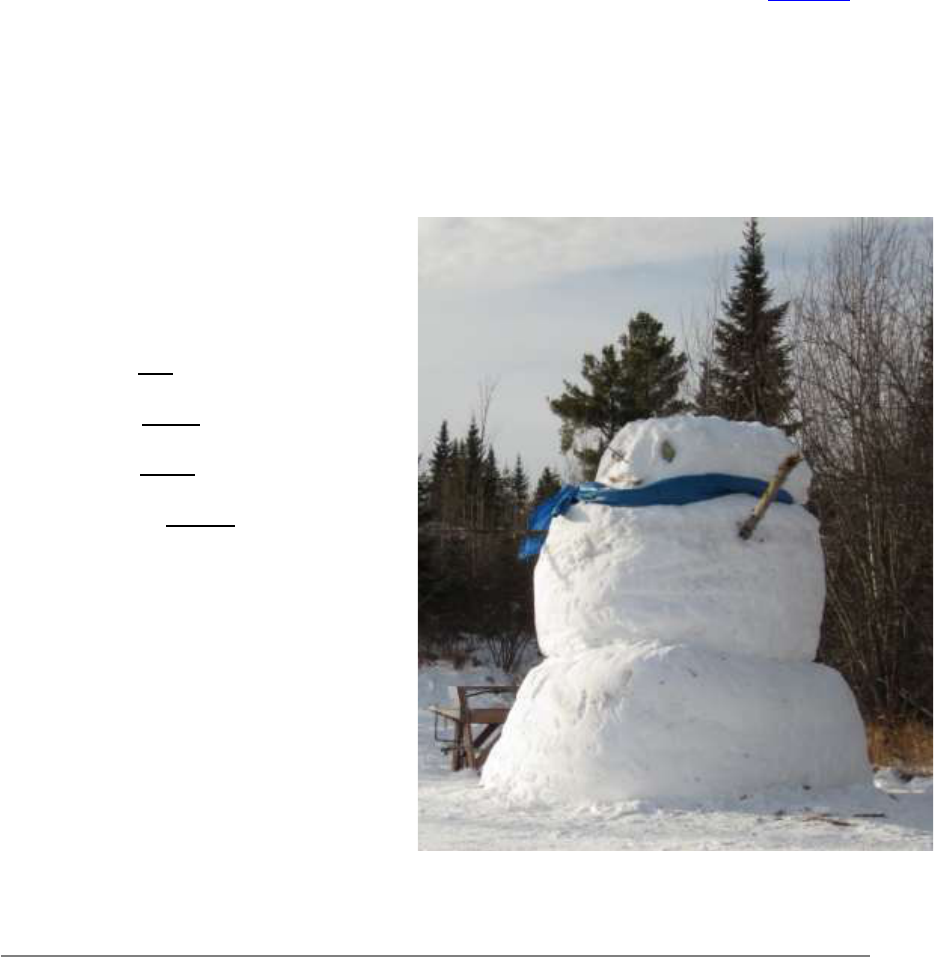
Welcome!
For over forty years the Okpik program of Northern Tier National High Adventure Programs has provided safe,
exhilarating, and challenging adventures for thousands of youths and adult participants. The name, Okpik,
comes from the Inuit word for the Arctic or Snowy Owl which has been used as the symbol for the Okpik program
since it began in the early 1970’s.
Okpik Participants learn how to cross-country ski, snowshoe, dogsled, ice fish, build snow shelters and enjoy life
in extreme weather conditions and temperatures. All groups are accompanied by a trained staff instructor,
called an Interpreter, who serves as a teacher of cold weather camping skills. The Okpik program fully outfits
crews with group gear and almost all necessary personal clothing (see the included gear list). The goal of the
Okpik program is to instruct crews on how to see low temperatures as an opportunity, not a barrier, to turn a
3-season camper into a year-round camper.
Okpik is hosted at the Charles L. Sommers base of Northern Tier, outside of Ely, Minnesota. Crews explore the
Superior National Forest and the famed Boundary Waters Canoe Area Wilderness (BWCAW), a massive
wilderness area that lies directly adjacent to the base property. No city lights, no noise, simply wilderness.
Okpik is the premier Cold Weather Camping Program of the Boy Scouts of America. We are excited by your
interest in cold weather camping, and we look forward to introducing you to the wonders of a North Woods
winter.
Pronunciation Guide
Ely - Ee lee
OKPIK - Ook pick
Bizhiw - Bee zhoo
Quinzhee - Quin zee

Contents
Why Winter Camp? ................................................................................................................................................................. 1
WHAT ARE THE RISKS? (RISK ADVISORY) ................................................................................................................................ 2
HOW DO I PREVENT PROBLEMS? ........................................................................................................................................... 2
WHAT ARE THE POLICIES? ....................................................................................................................................................... 3
Youth Protection Policies ........................................................................................................................................................ 4
OTHER GENERAL INFORMATION ............................................................................................................................................ 4
HOW DO I PLAN A TRIP? ......................................................................................................................................................... 5
Step 1: WHAT TRIP OPTIONS ARE THERE? .............................................................................................................................. 5
......................................................................................................................................................................................... 7
Step 2: How do I make my reservation and pay? ................................................................................................................... 8
WHAT’S THE REFUND POLICY?........................................................................................................................................ 8
WHAT EXPENSES ARE NOT COVERED BY THE NORTHERN TIER BASIC FEES? ................................................................. 8
Step 3: HOW DO I FULFILL ALL BSA POLICY REQUIREMENTS? ................................................................................................ 9
Step 4: HOW SHOULD WE PREPARE? ................................................................................................................................... 10
WHAT SHOULD WE BRING? .................................................................................................................................................. 12
Gear provided By Okpik ........................................................................................................................................................ 13
HOW DO WE PREPARE MENTALLY AND PHYSICALLY? ......................................................................................................... 14
Fishing Licenses ..................................................................................................................................................................... 15
How do we get to the base? ................................................................................................................................................. 15
Transportation options ......................................................................................................................................................... 15
Where can I stay en route to base? ...................................................................................................................................... 16
What can we see along the way? ......................................................................................................................................... 16
WHAT HAPPENS WHEN I ARRIVE AT BASE? .................................................................................................................. 16
HOW DO WE STAY IN TOUCH WITH OUR FAMILY AND FRIENDS WHILE WE’RE AT NOTHERN TIER? .................................. 16
WHAT ABOUT OUR FOOD? WHAT DO WE EAT? ................................................................................................................... 17
WHAT ARE THE HEIGHT AND WEIGHT REQUIREMENTS? ..................................................................................................... 18
Step 5: HOW DO WE GET THERE TO START OUR ADVENTURE? ........................................................................................... 19
OKPIK Check List .................................................................................................................................................................... 20
FIRST AID KIT ......................................................................................................................................................................... 21
SAMPLE ITINERARIES ............................................................................................................................................................ 22
SUGGESTED READING ........................................................................................................................................................... 24
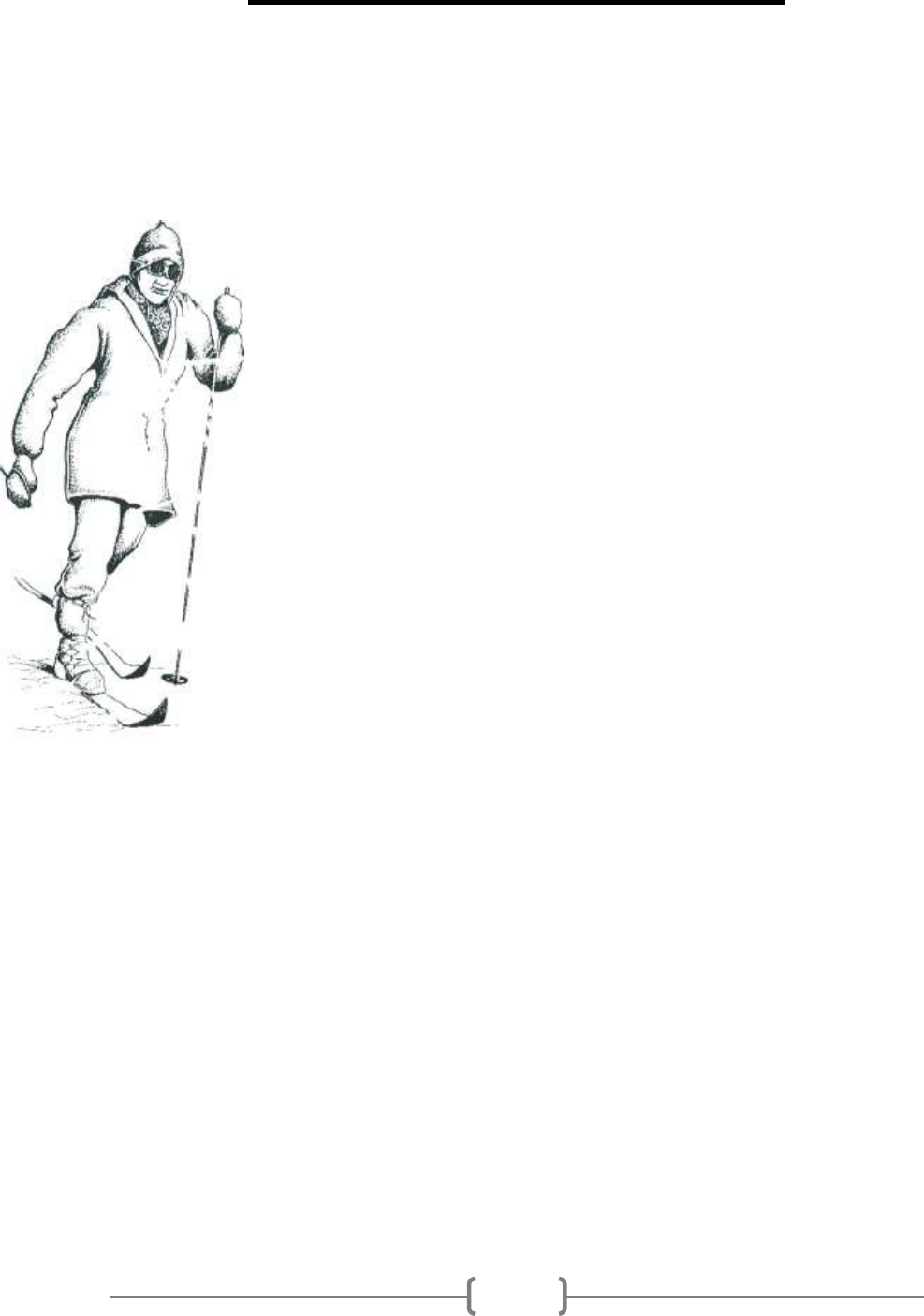
Okpik Advisor Planning Guide 2023-2024
1
LET’S GET STARTED
Why Winter Camp?
Many people do not know how to enjoy the winter, finding it an unpleasant season to be survived only by the
grace of the hefty insulation of a house. However, for the initiated, winter is one of the best seasons to be
outdoors.
For those intrepid enough to brave the icy conditions, greater solitude awaits. The
crowds of the summer ebb out, and lakes become quiet and intimate. One doesn’t
hear the hum of the bugs in the winter (some claim the lack of mosquitoes is the
best part of winter). Instead, there are the howling of the wolves and the silence of
the snow-dampened wilderness.
New activities abound in the winter and permit access to areas of the wilderness
that are rarely visited in the summer. At Okpik, scouts snowshoe over swamps and
bogs, cross-country ski on our groomed trail system, dogsled far out into the
wilderness or build their own warm, insulating structure out of snow. Almost
everyone tries something new at Okpik– and almost everyone develops a new
fascinating and thrilling skill.
We believe that every participant in our Okpik program will be entranced by the
glittering light of the sun on the snow, of the brilliance of the night stars, by the
clear-cut tracks of the moose and wolf and by the simplicity and solitude of the still
winter world. The Okpik program is designed to introduce anyone to these joys,
and to teach them how to thrive in perfect comfort as they navigate the exciting
challenges of winter camping.

Okpik Advisor Planning Guide 2023-2024
2
WHAT ARE THE RISKS? (RISK ADVISORY)
The Northern Tier National High Adventure Programs have an outstanding safety record. The Boy Scouts of
America and Northern Tier emphasize safety through education and strict adherence to established policies and
procedures. The safety of your group is dependent upon your attention to these procedures as well as being
physically fit, properly equipped and trained for the rigors of cold weather camping.
Northern Tier and the Boy Scouts of America’s policies and procedures, if followed, will minimize these risks as
much as possible. Parents, leaders, and participants should be advised that despite our best attempts at risk
management, it is not possible to remove ALL risk from a cold weather wilderness expedition.
• Possible risks include (but are not limited to) motor vehicle accidents; severe weather conditions such
as extreme cold temperatures and high winds; medical conditions such as heart attack, appendicitis,
hypothermia, dehydration, frost bite, severe allergies and asthma or diabetes related conditions;
accidents such as cuts, embedded fishhooks, burns or falls; frost nip/bite risks associated with being on
frozen lakes and encounters with wildlife.
• Medical evacuations and search and rescue services are coordinated by Northern Tier in close
cooperation with local authorities.
• Please carefully read the information in this Okpik Advisor Planning Guide and share it with your crew(s),
leaders, and parents. If you have any further questions about risk management, contact Northern Tier
by phone 218.365.4811 or email [email protected]
HOW DO I PREVENT PROBLEMS?
• KNOW FIRST AID - Make sure your crew is trained in First Aid and carries the required first aid kit. At
least one advisor in each crew must be currently certified in CPR and Wilderness First Aid.
• PURIFY ALL DRINKING WATER - All water from natural sources must be purified by bringing it to a
rolling boil. Chemical treatments are less effective in the cold and water filters freeze.
• TOBACCO - It is strongly suggested that adult participants limit the use of tobacco on the trail.
Smoking is not permitted in the presence or vicinity of youth, tents, Northern Tier buildings, BSA
vehicles or near maintenance areas, only in designated areas on base.
• ALCOHOL AND DRUGS - Possession or use of alcoholic beverages, illegal drugs or the misuse of
prescribed drugs is prohibited. Groups or individuals found in violation of this National BSA policy will
be sent home, as arranged with the council office or parent.
• ABUSE - Physical, sexual, or emotional abuse (including hazing) of a camper by his or her peers or by an
adult leader is unacceptable anywhere. Local, county and state authorities as well as the BSA council
representative will be contacted if abuse is suspected.
• PRESCRIPTION DRUGS AND MEDICATION - If an advisor or crew member is on regular medication,
their physician should be consulted. Be sure to consult your physician to determine the effect cold
weather may have on your medications (i.e., inhalers or epinephrine) or effects your medications may
have on you in cold-weather conditions.

Okpik Advisor Planning Guide 2023-2024
3
WHAT ARE THE POLICIES?
What are the requirements to attend Northern Tier? (Updated 9.12.2023)
• Every Northern Tier Crew must have a minimum of two youth under the age of 18. We strongly recommend
that the majority of the crew is made up of youth.
• Each crew MUST always have at least TWO BSA registered adults (called “Advisors”) age 21 or older.
• Okpik Program Age Requirements:
o Dog Programs, Okpik Weekends, Trek Programs: All participants must be at least 14 years old or 13
years old and currently enrolled in 8
th
grade.
o Cabin Stay Program: Scouts can fall below the minimum 14 age, but they will only be allowed to stay in
cabins and this program is not eligible for the Triple Crown or Grand Slam Awards.
• All participants must fall below the maximum allowed weight for participation, and it is strongly recommended
that no participant weighs less than 100 pounds.
• All participants must have a current (within 12 months) and completed BSA Health and Medical Record. The
doctor completing the form must review the Northern Tier Risk Advisory included with the form. The Northern
Tier form can be found at https://www.scouting.org/health-and-safety/ahmr/
• All participants must be a registered member of the Boy Scouts of America.
• Crews with coed youth members must function under appropriate co-ed unit policies.
o Scouts BSA Troops: Scouts BSA is a single gender program and units must register and participate as single-
gender units. Male and Female Scouts BSA units can attend Northern Tier together if the troops are linked
and each troop provides their own leadership in the Northern Tier Crew.
o Venturing Crews: The venturing program is a co-ed program and units may register and participate as a co-
ed crew. All youth must have a buddy of the same gender on the crew.
• Tenting Policies
o Separate tenting arrangements must be provided for male and female adults as well as for male and
female youth.
o Youth (14-17) cannot share tents with anyone 18 or older (including parent)
o Youth under 18 may share tents only if there is no more than 2 years age difference.
o Spouses may share tents.
Unregistered guests or family members are NOT permitted to camp at Northern Tier. There are no scheduled
programs or available housing accommodations for family members of expedition participants.
Age
BSA/Youth Protecon Policies
Under
18
• Must be registered in a Youth position.
18-21
• Must be current in Youth Protecon training.
• Must be registered in an adult position.
21+
• At least two Registered leaders are required.
• A Registered female adult leader 21 years of age or over must be present for any
acvity involving female youth.
• Must be current in Youth Protecon training.

Okpik Advisor Planning Guide 2023-2024
4
Youth Protection Policies
Northern Tier takes Youth Protection very seriously. Some of the Youth Protection policies that apply to
participants at Northern Tier (and throughout Scouting) relate to registration and training. The complete
set of Youth Protection policies may be found at https://www.scouting.org/health-and-safety/gss/
All registered adults must have current BSA Youth Protection Training (certified within the past two
years). This means all participants 18 years old and older who are registered in Venturing, Exploring, Sea
Scouting, or as an adult volunteer must have current Youth Protection Training. Because of the great
concern the Boy Scouts of America has for the issue of child abuse in our society, the Youth Protection
program has been developed to help safeguard both our youth and adult members. Adult BSA
Registration requires verification of Youth Protection Training. All adults participating in a Northern Tier
expedition must be registered.
Youth Protection Training and documentation are available at your local council
or online at https://www.scouting.org/training/youth-protection/.
Northern Tier will strictly enforce Youth Protection policies, which include the Barriers to Abuse within
Scouting. (https://www.scouting.org/health-and-safety/gss/gss01/#a).
Adult Leadership Training
– All adult participants are required to present proof of BSA Youth Protection training upon arrival at
Northern Tier. At least one adult in each crew must have proof of current CPR, Wilderness First Aid and
Hazardous Weather training.
Unregistered guests or family members are NOT permitted to camp at Northern Tier. There are no
scheduled programs or available housing accommodations for family members of expedition participants.
OTHER GENERAL INFORMATION
CAMPERSHIPS – Youth with extenuating financial circumstances who are participating in an Okpik program
may apply for funding assistance to attend Okpik. Camperships are determined on a need basis. The
campership application is found on our website at http://www.ntier.org/. The completed application form(s)
and other required documents must be returned by mail to Northern Tier no later than September 1. The
camperships are reviewed in November with notification given to the crew advisor prior to the final crew
payment due date.
INSURANCE - Northern Tier fees include accident and sickness insurance coverage. This applies for your travel
to and from the Northern Tier base as well as your Northern Tier Expedition. This policy is secondary to a family
policy. All participants with family insurance should include the insurance company name and policy number
on their BSA Health and Medical Record form and should also submit a copy of the insurance card with the
medical form. A BSA Camper's Accident and Sickness Insurance pamphlet will be sent in the Advisor packet and
is also available online at http://www.ntier.org/.
EMERGENCY PHONE NUMBER
If there is a home emergency while your crew is attending Northern Tier, please contact
Northern Tier at 218.365.4811.

Okpik Advisor Planning Guide 2023-2024
5 5 5
HOW DO I PLAN A TRIP?
Northern Tier makes planning an Okpik trip simple. At any point along the way, we encourage you to contact
us via e-mail ([email protected]) or phone (218.365.4811) with any questions. Paperwork for High Adventure
Trips often requires a meticulous eye. It is easier for you and Northern Tier if you contact us with a question
rather than arrive at our base with a paperwork issue.
The planning process is a 5-step plan:
1) Trip Selection
2) Reservation and Payment
3) Fulfillment of BSA Policy Requirements
4) Personal Preparation (physical, mental, gear)
5) Arrival and Enjoyment of Trip
The Wilderness
Northern Tier crews explore massive wilderness areas, where solitude allows for deeper meditation and the rugged
terrain and mercurial elements provide for physical challenge. The wilderness is part-classroom and part-instructor in
the Northern Tier experience.
Step 1: WHAT TRIP OPTIONS ARE THERE?
Okpik provides a variety of different program options to help crews plan trips that match their desires and
needs.
• Introductory treks (Cabin Stay Program) that acquaint scouts with the basics of outdoor winter
activities.
• Intermediate treks (Okpik Camping Weekend) that focus on developing higher skills, like snow
camping, snowshoeing, cross-country skiing, etcetera.
• Dog Sled programs include:
o Musher Camp, which serves as an introduction to dog sledding.
o Remote Musher Camp which sends scouts to a working dogsled kennel to learn about
dogsledding firsthand.
o Dog Trek program which combines winter camping skills with the thrill of dogsledding.
o Remote Dog Trek which pushes scouts even further into the wilderness via dogsled.
Most trips occur over weekends throughout the winter months (January to the first weekend of March) except
for our Holiday Stay Program. The Holiday Stay opens the season (December 27 – January 3) and allows crews
to take longer trips and to customize their experience to a greater degree.
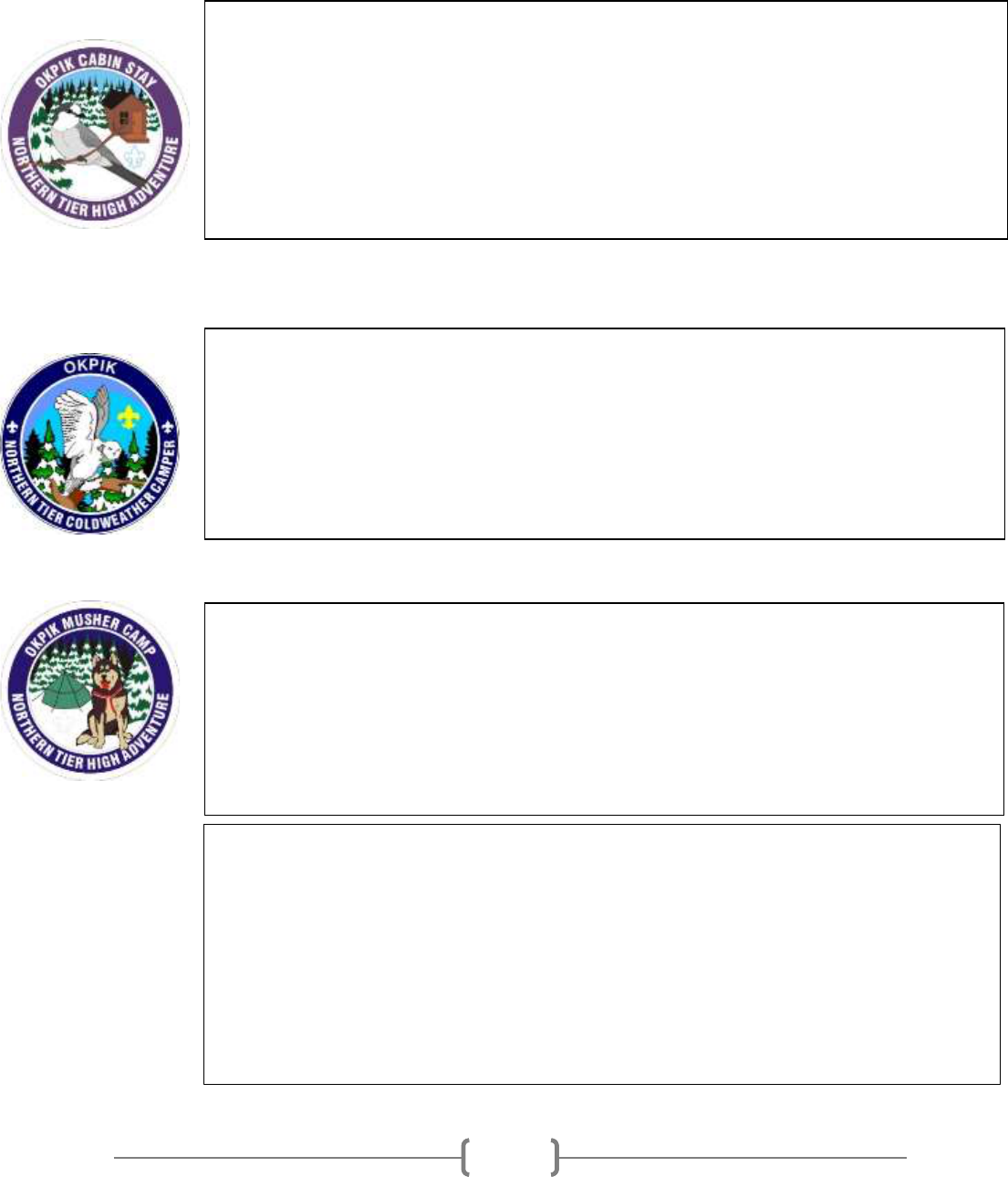
Okpik Advisor Planning Guide 2023-2024
6 6 6
Overall, the planning of trips is very flexible. The Okpik staff looks forward to working with you to design the
trip that best suits your abilities and interests. A more detailed program description is included on the next
page.
INTRODUCTORY TREKS
INTERMEDIATE TREKS
DOG PROGRAMS
OKPIK COLD WEATHER CAMPING WEEKEND provides a basic introduction to camping in
winter conditions. Participants will hike out to a wilderness lake, towing their gear in sleds
(pulks), set up a campsite and spend the one- or two-nights camping. In addition, they will be
exposed to a wide variety of winter activities: snowshoeing, ice fishing, skiing and more.
Minimum age is 14 or 13 and in 8
th
grade by the time of arrival at base. Maximum group size is
11 and minimum group size is 6. Participants will receive the Okpik Cold Weather Camper
Award.
OKPIK CABIN STAY participants will be able to experience a full range of winter activities while
still being able to enjoy a heated cabin at night. Crews will take day trips out to lakes in the
area, learning how to ski, snowshoe and ice fish in the process. They will also learn how to
cook breakfast and dinner meals in winter conditions. Minimum age is 11 or must be a
registered Scouts BSA member or Venturer by the time of arrival at base. Crews with multiple
scouts under the age of 14 are urged to bring additional adult leadership to help manage the
needs of the crew. Maximum group size is 11 and minimum group size is 6. Participants will
receive the Okpik Cabin Stay Award. Okpik Cabin Stay does not qualify for the triple crown
award.
OKPIK MUSHER CAMP provides participants with an introduction to dog sledding. Crews
spend their entire weekend with the dogs: going on runs of up to 10 miles every morning and
afternoon, providing other Okpik participants with information about dogsledding, feeding the
dogs breakfast and dinner, sleeping in a rustic cabin adjacent to the dog yard and cooking
meals in the winter. Trip length: 3 nights, arriving Friday and leaving Monday. Minimum age
is 14 or 13 and in 8
th
grade by the time of arrival at base. Maximum group size is 7 and
minimum group size is 6. Participants will receive the Okpik Cold Weather Camper Award and
may purchase the Okpik Musher Camp Award.
OKPIK REMOTE MUSHER CAMP provides participants with an introduction to dog sledding.
You will be shuttled to a Dogsled Kennel and setup a basecamp using snow shelters or tents.
You will learn and take part in daily chores around the dog yard. You will work with
experienced mushers who are excited to teach you all about these amazing animals. Along
with daily chores and taking the dogs for runs, you will also have a chance to ski/snowshoe in
your downtime. This program provides a great balance of winter camping and the dog
program. Trip length: 3 nights (including one spent on base) arriving Friday and leaving
Monday. Minimum age is 14 or 13 and in 8
th
grade by the time of arrival at base. Maximum
group size is 7 and minimum group size is 6. Participants will receive the Okpik Cold Weather
Camper Award and may purchase the Okpik Musher Camp Award.
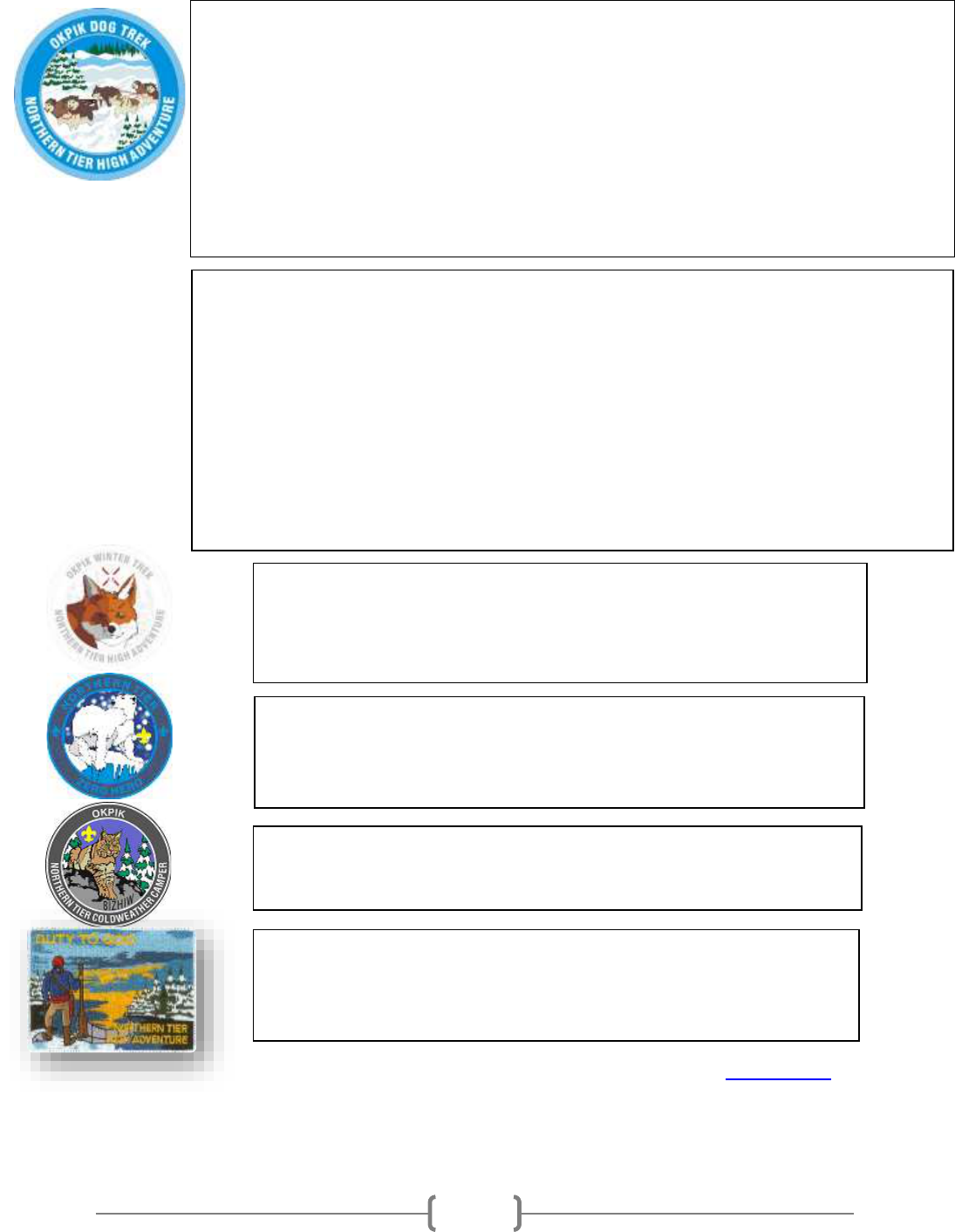
Okpik Advisor Planning Guide 2023-2024
7 7 7
Patches are available for purchase in the Northern Tier Trading Post.
OKPIK DOGSLED TREK – A step up from the Musher Camp, the Dogsled Trek is intended for
those who have some dog sledding or winter camping experience. It involves taking 18
Alaskan Huskies out on the ice for two nights! After setting up a base camp, crews will explore
the pristine and remote Boundary Water Canoe Area Wilderness on morning and afternoon
runs of up to 10 miles. Participants should be prepared to run, hike or snowshoe several miles
in addition to dogsledding. Trip Length: 3 nights (including one spent on base) arriving Friday
and leaving Monday. Minimum age 14 or 13 and in 8
th
grade by the time of arrival at base;
maximum crew size is 7. Participants will receive the Okpik Cold Weather Camper Award and
may purchase the Okpik Dog Trek Award if at least 2 nights are spent out on the ice.
The Okpik Winter Trek award is available for any crews that spend at
least 2 nights camping off base in the woods, change campsites at
least once and travel at least 7 miles.
The Zero Hero patch is available to any participant who camps
outside on a night where the temperature drops below 0 degrees
Fahrenheit (which means -1 or colder).
The Bizhiw Patch is available to any participant who spends two
nights off base.
The Duty to God award is available to scouts and adults who
participate in at least one daily devotional while at Northern Tier
and lead grace before one meal while on ice.
OKPIK REMOTE DOGSLED TREK: A step up from our Basic Dog Sledding programs, the Remote
Dog Sled Trek is intended for those that have previous dog sledding or winter camping
experience. This program will travel more significant distances from the Northern Tier Base,
sometimes even departing from or returning to another location all together. Crews will get a
more robust winter experience, in more extreme conditions. This program is better suited
towards those with previous winter camping experience. Trip Length: 3 nights (including one
spent on base) arriving Friday and leaving Monday. Minimum age 14 or 13 and in 8th grade
by the time of arrival at base; maximum crew size is 7. Participants will receive the Okpik Cold
Weather Camper Award and may purchase the Okpik Dog Trek Award if at least 2 nights are
spent out on the ice.

Okpik Advisor Planning Guide 2023-2024
8 8 8
Step 2: How do I make my reservation and pay?
Once you choose a program, reserving your place in the Okpik schedule is very easy. You will need to know the
dates you would like to arrive and depart as well as the number of participants who will be attending. Okpik is
very flexible in accommodating the logistical and scheduling needs of any crew – trips take place on weekends
with crews arriving Thursday or Friday and departing Monday or Sunday.
Participants are grouped into crews. Each crew must have at least 6 and no more than 11 crew members
including two adults. If your crew numbers more than 8 people, you will NOT be able to venture into the
BWCAW.
If you navigate to the “Registration/Planning” page on our website, you can access our Trip Availability Chart.
Reservations are available on a first come first served basis starting in January the year prior. See our website
for details. Alternatively, you can contact Northern Tier by phone (218.365.4811) and our Registrar will
provide you with the information you need.
If anyone in your trip has dietary restrictions or needs, please communicate this information by submitting a
request using the roster system in your reservation. Northern Tier accommodates a wide variety of dietary
issues if given advance notice. There is a $75 fee for special diet foods and not all special diets can be
accommodated. Our food service team will reach out and talk with you about the options.
WHAT’S THE REFUND POLICY?
All fees (deposit, first payment and final payment) are non-refundable and non-transferable in event of
cancellation. Exercise caution in making reservations or paying fees for anyone who has not made a
financial commitment. Northern Tier High Adventure Programs must commit financial resources to employ
staff, purchase food and supplies, and prepare for base operations. Participants are, therefore, also required
to make a financial commitment to attend. Be conservative in making reservations to avoid losing fees due to
cancellations.
In rare & extenuating instances, we may determine that conditions do not allow us to present the Okpik
programs. In this instance, you will be notified, and all fees will be refunded or transferred to future trips.
WHAT EXPENSES ARE NOT COVERED BY THE NORTHERN TIER BASIC FEES?
• FOOD: An evening meal is available for any crew arriving prior to 7:00pm. Crews that plan to arrive after
7:00pm or get delayed should plan on eating dinner en route to the base. A list of restaurants in Ely can
be found by going to www.ely.org.
• FISHING: All participants who wish to Ice Fish during their Okpik experience must possess a valid
Minnesota fishing license. Fishing Licenses may be bought online in advance of your trip. This is the best
way for you to purchase your license.
o To purchase your fishing license online go to.
http://www.dnr.state.mn.us/licenses/fishing/index.html?type=fishing
o Please refer to the Minnesota DNR website for all fishing regulations and rules:
http://www.dnr.state.mn.us/regulations/fishing/index.html
• PATCHES: Program patches for Bizhiw, Zero Hero, Winter Treks, Dog Trek, Musher Camp and Duty to God
can be purchased (if requirements are met) in the Trading Post.

Okpik Advisor Planning Guide 2023-2024
9 9 9
WHAT IS MY CREW NUMBER?
In your confirmation email, you will be given a crew number. This number should be referenced in any correspondence
with Northern Tier. Your crew number is assigned to you based upon which program you are participating in, the date you
are arriving and the number of crews that you have
CREW PHOTOGRAPHS
When you arrive at Northern Tier each crew has a photograph taken. You can order copies of pictures online at
https://northerntierphotos.smugmug.com/
Step 3: HOW DO I FULFILL ALL BSA POLICY REQUIREMENTS?
Northern Tier is a National High Adventure Base of the Boy Scouts of America. Consequently, every group that
arrives on base for a trip must meet certain requirements. Below the required pieces of paperwork that every
crew must have with them upon arrival at base are listed.
Please read carefully: If you do not bring the required paperwork, you will not be allowed on your trip.
BSA REGISTERED ADULTS AND YOUTH - All adults accompanying a Scouting unit who are present at the
activity must be registered as leaders. Apply for BSA registration through your local council.
HEALTH AND MEDICAL RECORDS - All participants, adult, and youth, must bring a completed Northern Tier
BSA “Health and Medical Record” signed by a medical doctor. Okpik is a physically taxing program in a rugged
area and participants must be fit enough to meet the challenge: participants are required to fall within the
minimum and maximum height/weight requirement on the Health and Medical Record. Northern Tier strongly
recommends that all participants fall within the recommended weight for their height for the reasons of safety
and enjoyment of the programs. The maximum and minimum weights are the absolute maximum and
minimum. THOSE FALLING ABOVE 295 POUNDS (250 POUNDS FOR DOG PROGRAMS) WILL ABSOLUTELY NOT
BE PERMITTED TO PARTICIPATE. You do not want to fall above or below those requirements. Forms are
available at www.ntier.org.
FIRST AID KIT: Each crew is responsible for bringing a complete First Aid kit. See page 22 for recommended
First Aid Kit supplies.
TRAINED ADULT LEADERSHIP –
• All participants over the age of 18 must have proof of BSA Youth Protection Training.
• One adult per crew must have proof of Wilderness First Aid training, CPR training and BSA Weather
Hazards training.
AGE REQUIREMENTS – Northern Tier expects crews to abide by the Age Requirements of their program. Youth
participants should be put in programs that are appropriate for their physical abilities and maturity levels.
Cabin Stay Crews with multiple scouts under the age of 14 are urged to bring additional adult leadership to
help manage the needs of the crew.

Okpik Advisor Planning Guide 2023-2024
10 10 10
Step 4: HOW SHOULD WE PREPARE?
The Crew
All Northern Tier participants belong to a crew. Crews vary in size (during Okpik crew size can range from 6-11 members,
dog crews have a maximum size of 7 participants), but all crews consist of at least two adult leaders, a youth crew leader
and a majority of youth participants. A Northern Tier Interpreter accompanies all crews.
Larger troops will be divided into “sister” crews. Though sister crews may know each other, they will have independent
experiences while at Northern Tier to maintain the integrity of the wilderness program. Sister crews will have limited
interaction in the wilderness.
The Crew Leader
The Program of the Boy Scouts of America is specifically designed to develop youth leadership. A well-qualified Scout or
Venturer should be selected as the Crew Leader early in the planning of each Northern Tier Expedition. The Crew Leader
is responsible for leading the discussion of the Crew’s route selection, organizing the pace of travel during the day and
establishing the Crew duty roster for camp chores.
The Advisor
The Crew Advisor serves as a counselor and coach to the Crew Leader. The Crew Advisor is also responsible for ensuring
the safety of everyone in the crew: all Crews are required to have an adult with training in Wilderness First Aid and CPR.
Finally, the Crew Advisor addresses crew conflicts that may require appropriate discipline.
The Interpreter
The Interpreter is a Winter Camping Counselor who serves as a teacher and resource for the Crew Leader and Crew. The
Interpreter has received special training in the best practices for winter camping adventures. The Interpreter aids the
Crew Advisor in ensuring the safety of the crew. Finally, the Interpreter is responsible for imparting the unique flavor,
history, culture, and adventurous spirit of the North Country to the crew.
Okpik makes winter camping easy and simple by providing crews almost everything they need. All food is pre-
packed by your Interpreter and ready to go on arrival. All cooking gear – stoves, fuel, pots, utensil kit, etc. –
await your inspection upon arrival. All the tools necessary for spending several nights in the elements are
provided. In addition, almost all significant recreational equipment is available free of charge. Snowshoes,
cross-country skis, and basic ice fishing equipment are all stocked ready-for-use in our Bay Post.
Okpik outfits participants who need it with almost all personal clothing. Cold weather sleeping bags, sleeping
pads, wind pants, wind jackets (anoraks), boots, water bottles and more are provided by Okpik’s outfitting
department. Participants must bring their own hats, long underwear, wool socks, summer rated sleeping bag,
flashlight, bowl, and spoon; participants are encouraged to bring their own fleece pants and shirt.
Finally, Okpik provides an Interpreter to educate participants on how to winter camp in the most comfortable,
safe, and fun manner. Almost everyone who arrives at Okpik is new to winter camping; prior experience is not
necessary.
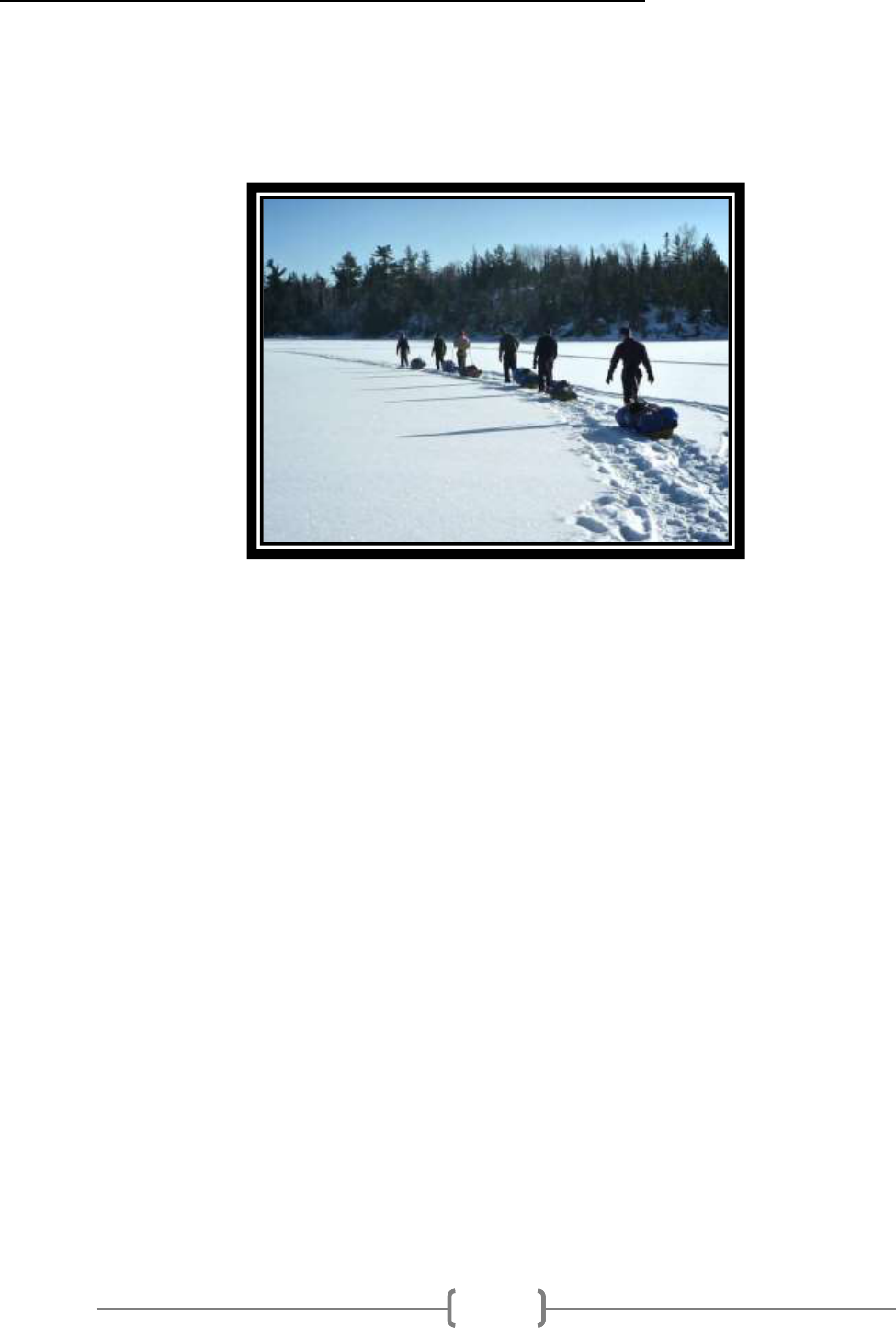
Okpik Advisor Planning Guide 2023-2024
11 11 11
However, better prepared scouts and advisors have more satisfying trips. While Okpik provides most of the
gear you might need, acquiring your own gear (which you can break in beforehand) may increase your
comfort. Okpik participants are strongly advised to arrive mentally prepared by reading the OKPIK
PARTICIPANT HANDBOOK and the OKPIK COLD WEATHER CAMPING GUIDE, to give themselves a basic
understanding of cold-weather camping practices before they arrive. Training with weighted boots may help
prepare for walking through snow in insulated boots.

Okpik Advisor Planning Guide 2023-2024
12 12 12
WHAT SHOULD WE BRING?
Okpik provides almost all the gear required for a safe and satisfying winter camping adventure. However, each
individual and each crew will need to bring some of their own personal gear.
Personal Gear:
Required:
Stuff sacks (33 liter or less) or small duffel bag for all personal gear (DO NOT plan to take large suitcases or large packs on
trail)
o A few small bags will help to organize your stuff on your sled and prevent losing items on trail. These are very
helpful for keeping organized.
2 Winter Hats (preferably fleece)
o Beanies or bomber hats work well, hats must cover the ears.
2 pairs of synthetic long underwear (tops and bottoms; NO COTTON)
o Can be heavy weight or mid weight, this layer should fit snug and involve a wicking material designed to keep
you dry when sweating.
2 pairs liner gloves
o Thin knit gloves to provide some protection while allowing dexterity. These will be worn under thicker gloves
or mittens. Should be loose enough to allow for good blood flow to fingers.
2-3 pairs wool or heavy synthetic socks
o Should be loose enough that they don’t restrict blood flow to feet.
2-3 pairs synthetic liner socks
o Optional but recommended, these assist in wicking sweat away from the feet.
1 compass
o If liquid filled will need to be kept warm
3-Season Sleeping bag. This will be combined with an Okpik issued Cold Weather sleeping bag.
o No temperature rating requirement, a summer weight bag (20 to 30 degrees) would work well.
Headlamp or flashlight and extra batteries (MUST HAVE – days are short in the winter)
Toiletry articles (toothbrush, toothpaste, etc.) *
Plastic Cup, bowl, and spoon
Items for showering* (towel, soap, etc.) and clothes for the trip home
Scarf or Neck Gaiter*
o Fleece or wool work well
Sunglasses* or Ski Goggles
o Optional but recommended to protect the eyes from bright sunlight reflecting off the snow.
The following items are available for outfitting, though you may feel more comfortable in your own:
2 pairs wool or fleece pants
o Northern Tier provides all participants with fleece pants if needed, this is your warm layer which traps heat
radiated by your body.
2 sweaters* – preferably wool or polar fleece
o Multiple warm layers can be combined to increase insulation on trail allowing people to adjust layers depending
on weather and physical activity.

Okpik Advisor Planning Guide 2023-2024
13 13 13
2-3 pairs of mittens* (mittens are warmer than gloves)
o Northern Tier provides fleece mittens with a nylon shell, large enough to wear liner gloves underneath.
1 wind jacket
o Should have a hood and extend well below the waist, pockets are beneficial, this is your outermost layer so should
be big enough to go over multiple other clothes without restricting movement. Breathable fabric helps allow
moisture to pass while you sweat.
1 pair snow pants or rain pants
o This is your wind layer bottom, should be water resistant and breathable. Must be big enough to go over multiple
layers without restricting movement.
Cross Country Skis and snowshoes
o Northern Tier provides a variety of skis and snowshoes, participants are welcome to bring their own as well.
Warm/winter boots (e.g., Sorels or Kamiks) with removable liners
o Must have removeable liner to dry overnight, waterproof boots are preferred. Northern Tier provides all
participants with 1 pair of Sorel Glacier XT (rated to -100) or Sorel Caribou (rated to -40) participants should bring
some sturdy boots to use before outfitting so that you can travel to the cabin the first night.
The following items are recommended but not provided by Okpik.
Suspenders (better than a belt in cold weather)
o Holds pants in place without restricting blood flow or heat distribution between legs and torso.
Fleece or Puffy Vest
o Retains more heat in your core.
Pocketknife/matches/bandana *
Sunscreen and Chapstick *
Camera and film
Day pack or fanny pack
PLEASE NOTE: While Northern Tier strives to have clothing available for all sizes, we are limited in the number of XX-L items. For these sizes or
larger, we recommend that participants bring their own.
*These items are available for purchase in the Trading Post or online at www.ntier.org.
Gear provided By Okpik
Northern Tier strives to provide most of the gear that you will need to stay safe and have fun. All participants are
responsible for bringing at least two full sets of all the layers that come in immediate contact with skin (base layer top
and bottom, socks, liner gloves(thin), and thick knit caps). A brief description of the clothing provided by Northern Tier is
available below. During winter activities all clothing must be loose fitting so as not to constrict blood flow which could
cause cold fingers and toes.
Fleece pants and jacket- this is your warm layer, designed to provide insulation and trap the warm pocket of air created
by the heat of your body. Multiple thin layers provide ample protection and allow you to regulate body temperature by
shedding layers as your activity level increases.
Wind pants and jacket- this is your wind layer, designed to block wind from blowing away the warm bubble of air
contained in your warm layer. Usually, a thin weatherproof layer is designed to block the wind. Wind jackets typically
come with a hood and extend below the waist. This layer will also provide protection from snow and moisture when
sitting, sledding, or hollowing quinzhees.
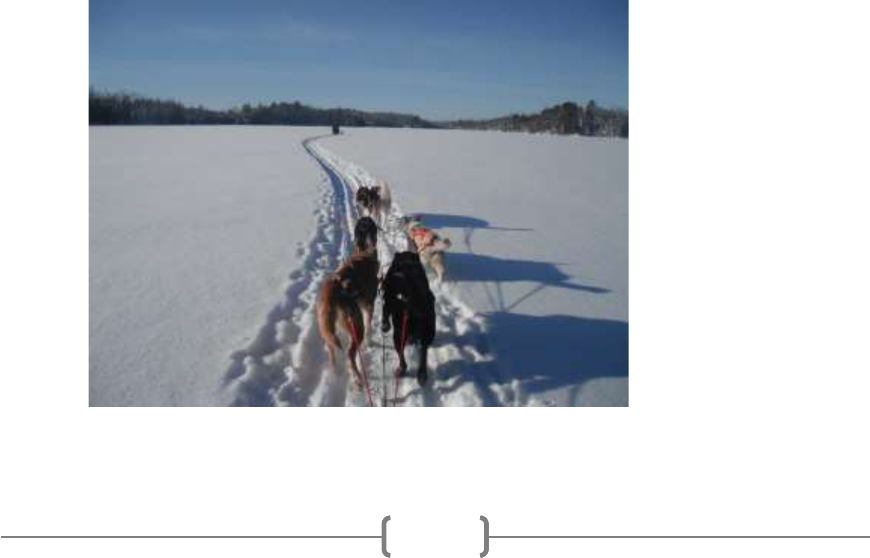
Okpik Advisor Planning Guide 2023-2024
14 14 14
Mittens- Northern Tier provides mittens in layers consisting of a fleece or wool warm layer and a nylon or leather
wind/moisture proof layer. This combination provides warmth and protection from moisture. For maximum versatility
you’ll want to provide your own pair of liner gloves to provide protection when you also need dexterity.
Boots- Northern Tier provides each participant with a sturdy pair of winter boots with removable liners. Our boots are
rated to temperatures lower than -40 degrees Fahrenheit.
HOW DO WE PREPARE MENTALLY AND PHYSICALLY?
Winter Camping requires a good deal of stamina. The cold temperatures drain energy, as the body spends
more effort working to keep itself warm. While out on the ice, you can expect to expend far more calories
than you normally would – 4,000 - 5,000 would be a good estimate!
Because of these factors, arriving at Okpik in good physical condition will enhance the enjoyment of your trip.
Try to exercise for thirty minutes three times a week for at least the month before you arrive at Okpik. We
recommend, in particular, high amounts of cardiovascular exercise. Pulling a sled, snowshoeing, skiing, and
dogsledding all require significant cardiovascular capacities. Run, swim and be active to prepare for your trip;
ankle weights help to simulate the experience of walking in winter boots. It is also a good idea to do at least
one overnight preparation trip before you attend Okpik. Dogsledding, in particular, requires significantly
more running than you might expect, if you are signed up for a dog program be prepared to run and jump in
your winter clothes and boots.
Winter camping is a fascinating and little studied branch of outdoor skills. We encourage you to study up on
the various techniques and approaches to winter camping. Spending several days in the cold requires a
methodical and meticulous approach to even the most mundane tasks. Begin your preparation by reading
through the Okpik Guide to Winter Camping. If you find that fascinating, continue your education through the
books listed in our bibliography at the end of this book.

Okpik Advisor Planning Guide 2023-2024
15 15 15
Fishing Licenses
Northern Tier recommends that all Fishing Licenses be purchased online in advance of your trip. If youth under the age
of 16 (for fishing in Minnesota) would like to fish, they can fish under the license of a single adult. However, their catch
will be restricted to this adult’s limit.
MINNESOTA FISHING LICENSES - All individuals, 16 years of age and older need to obtain a license to fish in the Superior
National Forest, licenses can be purchased in advance over the phone by calling 1-888-665-4236, or online. For current
pricing and license information visit http://www.dnr.state.mn.us/ NOTE: Regulations in Minnesota may be different than
what you are used to at home. Make sure to review these regulations when you purchase your license.
How do we get to the base?
Crews should arrive at Northern Tier between 1:00 and 3:00 PM for their Okpik program. Lunch should be eaten en-
route to the base as it will not be available for your crew upon arrival. You are responsible for your own transportation
to Northern Tier. Most crews will leave Northern Tier after lunch on the final day of their Okpik experience. Crews are
encouraged to plan their travel arrangements accordingly (Holiday Stay crews depart after breakfast on the final day of
their adventure)
The Ely base is located 20 miles east of Ely, Minnesota. Driving directions are included on the next page.
Transportation options
The Ely Canoe Base is 130 miles from Duluth, 270 miles from Minneapolis, 100 miles from Hibbing, and 20.2 miles
northeast of Ely. Crews using public transportation will need to arrange charter transportation to the Base.
GROUND TRANSPORTATION OPTIONS
Shubat Transportation
Hibbing, MN
888-874-8228
LCS Coaches
Cloquet, MN
888-743-3527
218-879-3391
Northern Lights Shuttle and Lodging
Biwabik, MN
218-780-2556
northernlights.shuttle.lodging@gmail.com
Voyageur Bus Co/MN Coaches Inc.
Duluth, MN
218-724-1717
Spirit of the Wilderness
Ely, MN
218-365-3149

Okpik Advisor Planning Guide 2023-2024
16 16 16
Where can I stay en route to base?
Crews traveling through Minneapolis or Duluth may plan to overnight at Northern Lights Shuttle and Lodging located at
Giants Ridge Ski Resort in Biwabik, MN. Giants Ridge offers lodging, food service, and recreation for Scouting groups at
very reasonable rates. Call 218-780-2556 for more information or www.giantsridge.com
If you plan on spending the night in Minneapolis consider staying at Northern Star Council’s Base Camp, an urban camp
located just a few miles from the Minneapolis – St. Paul airport, reservations can be made through blue sky adventures
at https://www.blueskyadventures.net/northern-tier/
For other lodging opportunities in the Ely area go to www.ely.org/lodging
What can we see along the way?
Minnesota is full of fascinating historical sites, terrific museums, and beautiful scenery. Check out our list of “Places to
Visit” here http://ntier.org/TripPlanning/Ely/ElyAttractions.aspx
WHAT HAPPENS WHEN I ARRIVE AT BASE?
The afternoon of your arrival will be busy! Please try to arrive on base between 1 and 3 PM. Be prepared for the
following:
• Meet your Interpreter.
• Carry personal and group gear to your crew’s assigned cabin (Do not pack in roller luggage, it is a rugged trail to
your cabin. Pack in a backpack or duffel bag.)
• Medical Screening of each individual.
• Crew Check In (presentation of paperwork, health forms, and copies of your certifications)
• Expedition Planning
• An Interpreter led shake-down of group and personal gear.
• Gear and food outfitting
• Dinner usually from 5-7 PM
• Orientation
HOW DO WE STAY IN TOUCH WITH OUR FAMILY AND FRIENDS WHILE WE’RE AT
NOTHERN TIER?
Remember that you will be embarking on a Wilderness Trek. Crews are strongly encouraged to leave connections to the
urban world on base when out on the trail. Cell phones are discouraged while in the wilderness. Northern Tier provides
a reliable means of emergency communication to each crew. Please leave your cell phones behind.
While on base, limited cell phone coverage exists and some service providers are better than others. Due to the remote
location of the base, we cannot guarantee any cell phone coverage. Similarly, Northern Tier has limited internet
connectivity available to crews.
If there is an emergency at home while you’re on trail, Northern Tier may be called at 218.365.4811 and we will get the
message to you as soon as we are able. Please note that this means we will not be able to get the message to you until
after you get off the ice. We do not maintain regular contact with our crews. Remember, you’re in the wilderness. Enjoy
it!

Okpik Advisor Planning Guide 2023-2024
17 17 17
WHAT IF THERE IS AN EMERGENCY WHILE ON THE TRAIL?
Before we discuss emergency communications, it is important to note that Northern Tier treks are true High Adventure
experiences, and your crew will be in a vast wilderness area. Northern Tier does NOT maintain regular communication
with our crews as it is not necessary and is a drain on resources. If an emergency does happen while on the trail, your
Interpreter should immediately contact the base and our management team will work with the Interpreter and Crew to
determine the best possible solution.
All Northern Tier crews are issued either an Emergency Radio or a Satellite Phone, depending on their route. Your
Interpreter is trained in the operation of these devices and will in turn train your crew. Unless otherwise incapacitated,
your Interpreter is solely responsible for any communication with the base.
Northern Tier has an amazing safety record, and we rarely must evacuate someone. When we do have to make that
decision, please realize that evacuations can take several hours as our primary method is to evacuate people on foot.
This is why it is imperative that every crew have an advisor certified in Wilderness First Aid, CPR, and Weather Hazards,
AND every crew must have a WELL STOCKED First Aid kit.
Trading Post (retail store)
Northern Tier’s Trading Post sells a large supply of gear, souvenirs, and snacks. Each participant spends on average $150
at the Trading Post. For more information go to https://store.ntier.org/
WHAT ABOUT OUR FOOD? WHAT DO WE EAT?
Your crew will typically eat three meals on base. The day you arrive, you will eat dinner in our dining hall. The next
morning before you hit the trail, breakfast will be served in the dining hall. You should plan on wearing your trail clothes
to breakfast, in order to expedite your departure on the trail.
After you get off the trail, you will eat lunch in the dining hall before you leave.
Holiday stay crews will spend their last night on base and will have dinner the night they come off trail as well as
breakfast the following morning in the dining hall.
While on the trail your crew will partake in some of the best trail food in the business. Our commissary is stocked
according to an expertly crafted menu. Your Interpreter spends the morning before you arrive at base packing your
food. After you arrive, your Interpreter will go through the trail food with you and explain what is included. This also
allows you and the Interpreter to double check and make sure everything is packed. your trail food will be waiting at
your cabin when you arrive.
We make every effort to accommodate special diet requests. The key to success is communication – the staff at
Northern Tier needs to know about Special Diet needs. They will communicate directly with the individual or individual’s
parents regarding those needs. Please fill out a dietary restrictions form on each participant with special diet needs at
the following link https://www.ntier.org/food/ . It is important that you provide us with a direct email and phone
number for that individual, so we can communicate with them. As previously stated, we make every effort to
accommodate special diet requests, but in some situations, it is not possible. In those situations, we will let the
individuals know what we can provide and ask them to supplement additional food on their own. If we can
accommodate the special needs, there will be a $75 fee for those accommodations.
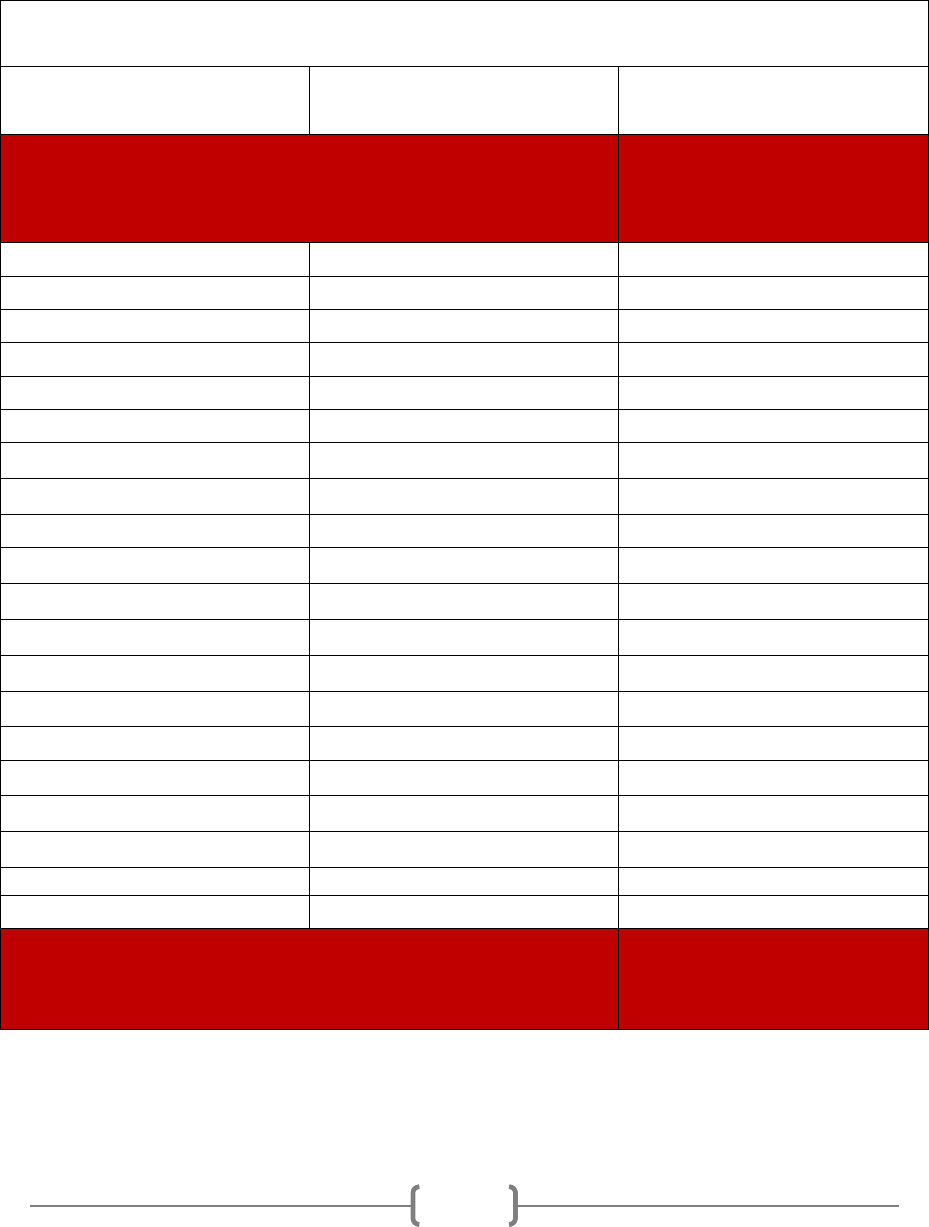
Okpik Advisor Planning Guide 2023-2024
18 18 18
WHAT ARE THE HEIGHT AND WEIGHT REQUIREMENTS?
The following table shows the recommended weights for each height, as well as the maximum weight for that height.
Northern Tier strongly recommends that each participant not exceed the maximum weight on the table for their height.
Northern Tier requires that you fall below the maximum (295 pounds and 250 pounds for dog programs) allowed weight
for participation. Additionally, Northern Tier strongly recommends that no Okpik Cold Weather Camping, Musher Camp
or Dog Trek participant weigh less than 100 pounds. Smaller participants will have a very difficult time due to the
strenuous nature of the trek.
Weight-to-Height Table
Northern Tier National High Adventure Programs
Height
Recommended Weight
(pounds)
Maximum Weight (pounds)
Minimum Allowed Weight
***Participants weighing less than 100 pounds will have a very
difficult time and are discouraged from attending. Not Applicable
to Cabin Stay.
100 pounds
5’ 0”
100 - 138
166
5’ 1”
101 - 143
172
5’ 2”
104 - 148
178
5’ 3”
107 - 152
183
5’ 4”
111 - 157
189
5’ 5”
114 - 162
195
5’ 6”
118 - 167
201
5’ 7”
121 - 172
207
5’ 8”
125 - 178
214
5’ 9”
129 - 185
220
5’ 10”
132 - 188
226
5’ 11”
136 - 194
233
6’ 0”
140 - 199
239
6’ 1”
144 - 205
246
6’ 2”
148 - 210
252
6’ 3”
152 - 216
260
6’ 4”
156 - 222
267
6’ 5”
160 - 228
274
6’ 6”
164 - 234
281
6’ 7” +
170 - 240
295
Maximum Allowed Weight
***No participants weighing more than 295 (250 for dog
program) pounds will be allowed to participate.
295 pounds
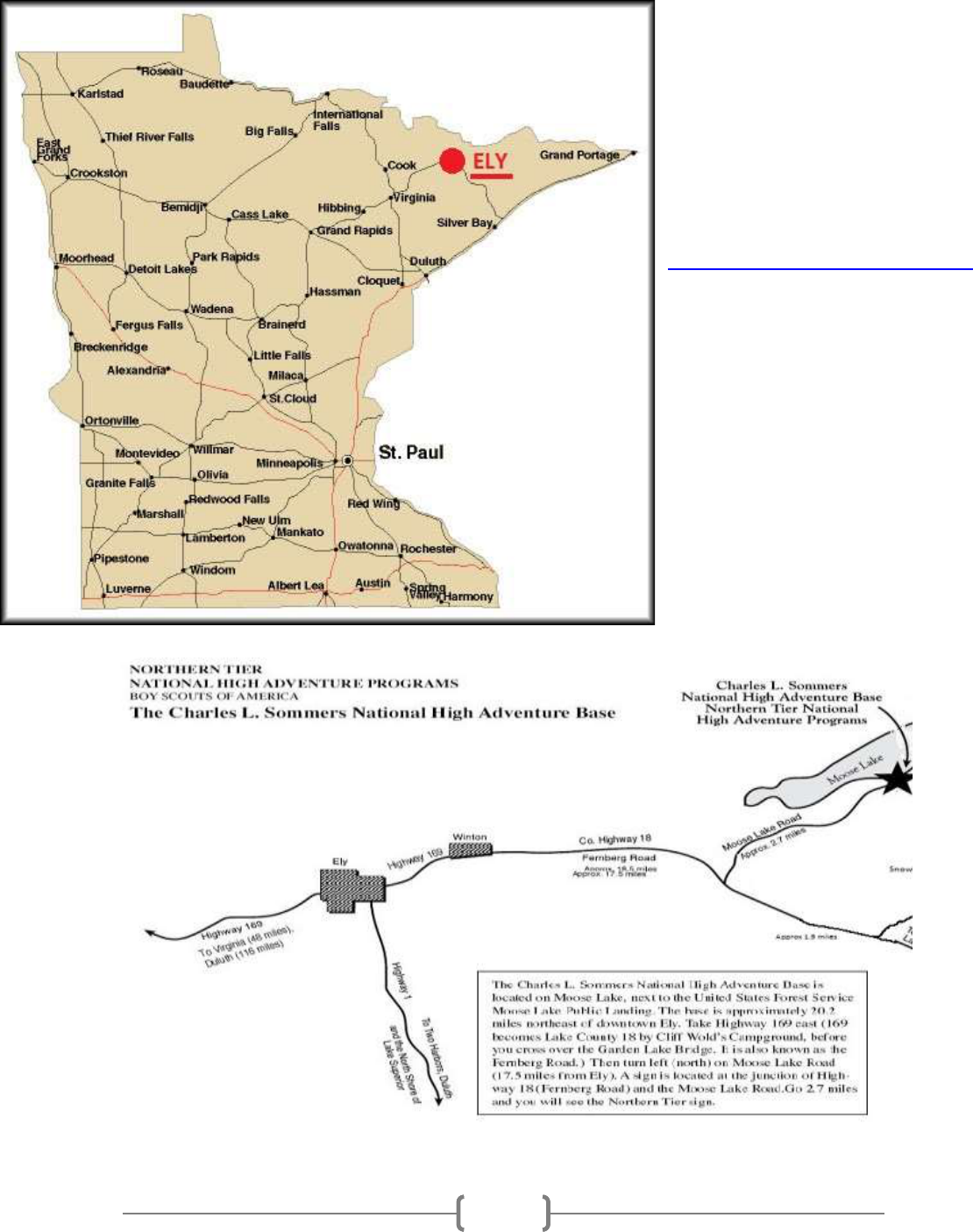
Okpik Advisor Planning Guide 2023-2024
19 19 19
Step 5: HOW DO WE GET THERE TO START OUR ADVENTURE?
You are responsible for your own
transportation to Northern Tier.
Okpik is based out of the Ely base,
located approximately 20 miles east
of Ely, Minnesota. If you have
questions about shuttle services,
please visit our webpage at
http://www.ntier.org/reservations/

Okpik Advisor Planning Guide 2023-2024
20 20 20
OKPIK Check List
CHECK, DOUBLE CHECK AND TRIPLE CHECK BEFORE LEAVING HOME
❑ ❑ ❑ Adults and youth have a completed Northern Tier BSA Health and Medical Record signed
by a doctor within the last 12 months. Youth also have a parent or guardian sign the
form.
❑ ❑ ❑ Copies of required certification cards: Youth Protection for all adults over 18. One adult
must have proof of Wilderness First Aid, CPR and Weather Hazards.
❑ ❑ ❑ Required medications – two of each with one for user and one for advisor in case of loss.
❑ ❑ ❑ Adequate personal gear (see packing list in this book)
❑ ❑ ❑ Financial needs (cash, credit cards, checks, travelers’ checks, etc.)
❑ ❑ ❑ Submitted a Participant Roster via email. Form can be found here:
https://www.ntier.org/resources/winter/

Okpik Advisor Planning Guide 2023-2024
21 21 21
FIRST AID KIT
EVERY CREW MUST BRING ONE FULLY STOCKED FIRST AID KIT
All BSA crews are required to carry a first aid kit. The kit should be personalized to meet the needs of the crew. The BSA
National Health and Safety Committee recommend the following items for Scouting and Venturing units participating in
High Adventure activities. First aid kits should be stored in waterproof containers
1
for use en route as well as at Northern
Tier and should contain the following items.
* SHARE this list with all crew members, advisors, and parents prior to departure for Northern Tier.
**CHECK all medical forms prior to departure for Northern Tier, ensuring allergies and other special considerations are
noted. Be prepared to explain important information upon arrival.
***PRESCRIBED MEDICATION should be supervised by an adult advisor. Any person requiring a prescription medication
should personally carry the medication. A back-up supply should be in the kit.
1
Available in the Trading Post or online at www.ntier.org
Adhesive bandages (assorted sizes)
Knuckle and fingertip bandages
Steri strips
Moleskin/molefoam
Second skin
Gauze pads—3” x 3”
Adhesive tape—1” x 15’
1” or 2” roll of gauze
4” elastic bandage
Oval eye patch
Antibiotic ointment
Lip balm
Thermometer
Scissors
Tweezers
Safety pins
Side cutters
Nitrile or latex gloves
Barrier device for
resuscitation
Sunscreen
First aid manual
Disposable alcohol wipes
Triangular bandage
Acetaminophen
Ibuprofen tablets
Cold caplets
Antacids
Antihistamines
Steroid cream
Anaphylaxis kit (if needed)
Throat lozenges
Small bar soap

Okpik Advisor Planning Guide 2023-2024
22 22 22
SAMPLE ITINERARIES
OKPIK HOLIDAY STAY SCHEDULE (Dec 27-Jan 1 OR Dec 29-Jan 3)
Arrival Day
Day 2
Day 3
Day 4
Day 5
Departure Day
Arrive
Hit the trail!
Enjoy the trail!
Come Off trail
Go Home
December 27
Arrive between 1:00 and 3:00 PM and meet your Interpreter. You can eat in town prior to arrival, or you
can eat dinner at the base provided you arrive before 7:00 PM
Complete Check-In: pay any final fees, turn in BSA Health and Medical Records and discuss the specific trip
goals of your crew.
Get situated in your on-base accommodations and complete a Gear Shakedown
Get outfitted with group gear and supplemental personal gear.
Visit the Trading Post– remember, our Trading Post carries some of the items you are required to bring
(just in case you forget).
December 28-30
Breakfast at 7:30 AM in the program center.
Finish checking out group equipment and food. Prepare for hitting the trail.
Start your Okpik Adventure!
All meals after breakfast on Dec. 28 will be cooked by your group until the evening of Dec. 31. We recommend
spending the rest of the day setting up camp at one of our remote campsites.
December 31
Morning: Enjoy your last day on the trail. Begin preparations to return to base.
Mid-afternoon: Arrive back at base. Return borrowed gear, take a shower, and settle back into on-base
accommodations.
Dinner will be served between 5:00 and 7:00 pm in the dining hall.
Visit the Trading Post and celebrate the New Year!
January 1
Visit the Trading Post and Depart for home after breakfast at 7:30am in the dining hall.

Okpik Advisor Planning Guide 2023-2024
23 23 23
OKPIK COLD WEATHER WEEKEND SCHEDULE
You can learn a lot about your crew and your schedule by looking at your crew number. For example, crew
OWT012124-BC: This crew number shows that you are an Okpik Weekend 2-night arriving on 01-21-2024 and you
have 2 crews (crew B and crew C).
A 2-night crew arriving on 01-21-2024, would have a schedule that looks like this
Jan 21, 2024
Jan 22, 2024
Jan 23, 2024
Arrive at NTIER
Hit the Ice after
Breakfast
Return to NTIER after breakfast and
depart for home after lunch.
• Crew Number Decoder:
o OWT: Okpik Weekend 2-night
o OWH: Okpik Weekend 3-night
o OWF: Okpik Weekend 4-night
o PHS: Pre-Holiday Stay
o HS: Holiday Stay
o WBS: Winter Break Stay
o RDP: Remote Dog Program
o DST: Dog Sled Trek
o MUS: Musher Camp
Things to remember about your schedule:
• Be sure to arrive at Northern Tier between 1:00 and 3:00, to give you plenty of time to prepare for your
adventure.
• You always depart for home after lunch on your departure day. Take advantage of the time you have
planned and schedule your travel accordingly.
• If you are a cabin stay crew, you will return to your cabins each night to sleep.
• You will be preparing most of your meals at your campsite. Those meals served in the dining hall follow
this schedule:
o Breakfast 7:30-8:30 am
o Lunch 12:00-1:00 noon
o Dinner 5:30 -7:00 pm
• Your trek and program schedule will be determined by you, upon arrival and discussion with you guide.

Okpik Advisor Planning Guide 2023-2024
24 24 24
SUGGESTED READING
• Conover, Garret and Alexandra. A Snow Walker’s Companion: Winter Trail Skills from the Far
North
• Dunn, John M. Winterwise: A Backpacker’s Guide. Lake George, NY: Adirondack Mountain Club,
1997.
• Field Book. Irving, Texas: Boy Scouts of America, 1984.
• Forgey, William W. Basic Essentials: Hypothermia. Old Saybrook, CT: Globe Pequot Press, 1999.
• Gilpatrick, Gil. Building Snowshoes. Skowhegan, ME: Gil Gilpatrick, 1998.
• Gorman, Stephen. AMC Guide to Winter Camping: Wilderness Travel and Adventure in
Coldweather Months. Appalachian Mountain Club, 1991.
• Hampton, Bruce, David Cole and Denise Casey. Soft Paths: How to Enjoy the Wilderness Without
Harming It. Mechanicsburg, PA: Stackpole Books, 1995.
• OKPIK: Cold-Weather Camping. Irving, Texas: Boy Scouts of America, 1990.
• Prater, Gene. Snowshoeing, 4
th
Edition. Seattle, WA: The Mountaineers, 1997.
• Randall, Glenn. Cold Comfort. New York, NY: Nick Lyons Books, 1987.
• Stokes, Donald W. A Guide to Nature in Winter. Boston, MA: Little, Brown, and Co., 1976.
• Watts, May T. and Tom. Winter Tree Finder Nature Study Guide. Berkeley, CA: Wilderness Press,
1970.
• Weiss, Hal. Secrets of Warmth for Comfort or Survival. Seattle, WA: The Mountaineers, 1992.
• Wilkerson M.D., James A. hypothermia, Frostbite, and Other Cold Injuries – Prevention,
Recognition, and Prehospital Treatment. Seattle, WA: The Mountaineers, 1986.

